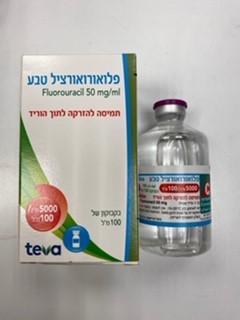Quest for the right Drug

פלואורואורציל טבע FLUOROURACIL TEVA (FLUOROURACIL)
תרופה במרשם
תרופה בסל
נרקוטיקה
ציטוטוקסיקה
צורת מתן:
תוך-ורידי : I.V
צורת מינון:
תמיסה להזרקה : SOLUTION FOR INJECTION
עלון לרופא
מינוניםPosology התוויות
Indications תופעות לוואי
Adverse reactions התוויות נגד
Contraindications אינטראקציות
Interactions מינון יתר
Overdose הריון/הנקה
Pregnancy & Lactation אוכלוסיות מיוחדות
Special populations תכונות פרמקולוגיות
Pharmacological properties מידע רוקחי
Pharmaceutical particulars אזהרת שימוש
Special Warning עלון לרופא
Physicians Leaflet
Pharmacological properties : תכונות פרמקולוגיות
Pharmacodynamic Properties
5.1 Pharmacodynamic properties Pharmacotherapeutic group: Antineoplastic agents, antimetabolites, ATC code: L01BC02. Fluorouracil fluorinated pyrimidine derivative, itself without antineoplastic effects. The inhibition of cell division occurs after metabolism by the active metabolites 5-fluorouridine triphosphate (FUTP) and 5-fluorodeoxyuridine monophosphate (FdUMP). Known mechanisms of action: • Blockage of DNA synthesis (inhibition of thymidilate synthetase by FdUMP). • Inhibition of RNA synthesis (formation of a defective RNA by incorporation of FUTP). • DNA strand breaks after incorporation of fluorodeoxyuridine triphosphate (phosphorylated FdUMP) into the DNA. The inhibitory effects are particularly evident in cells that grow rapidly and thus absorb fluorouracil to a greater extent.
Pharmacokinetic Properties
5.2 Pharmacokinetic properties Half-life After intravenous administration of fluorouracil (5-FU), the (monophasic) elimination half-life is 10– 20 minutes and is dose-dependent; a biphasic half-life of 8 and 40 minutes has been reported. Three hours after administration, 5-FU plasma levels are no longer measurable. Distribution The distribution corresponds to the total body fluid. Fluorouracil crosses the blood-cerebrospinal fluid barrier. Biotransformation Approximately 85% of the administered dose is metabolized. Active metabolites are the intracellularly formed 5-fluorouridine triphosphate (FUTP) and 5-fluorodeoxyuridine monophosphate (FdUMP). In addition to the active metabolites, 5-FU is mainly metabolized in the liver to inactive metabolites (major metabolites: 5-fluorouridine, 5-fluorodeoxyuridine) and catabolized to uracil. Carbon dioxide, urea and other metabolites are also produced. Elimination 15% of the administered amount is excreted unchanged within 6 hours by the kidneys, of which about 90% within the first hour. Fluorouracil is further catabolized by the enzyme dihydropyrimidine dehydrogenase (DPD) to the much less toxic 5,6-dihydro-fluorouracil (FUH2). The enzyme dihydropyrimidinase cleaves the pyrimidine ring to 5-fluoro-ureido-propionic acid (FUPA). Finally, β-ureido-propionase splits FUPA to α-fluoro-β-alanine (FBAL), which is excreted in the urine. The activity of dihydropyrimidine dehydrogenase (DPD) is rate-limiting. DPD deficiency may increase the toxicity of fluorouracil (see sections 4.3 and 4.4).

שימוש לפי פנקס קופ''ח כללית 1994
לא צוין
תאריך הכללה מקורי בסל
01/01/1995
הגבלות
תרופה מוגבלת לשימוש בבתי חולים או אשפוז יום
מידע נוסף
